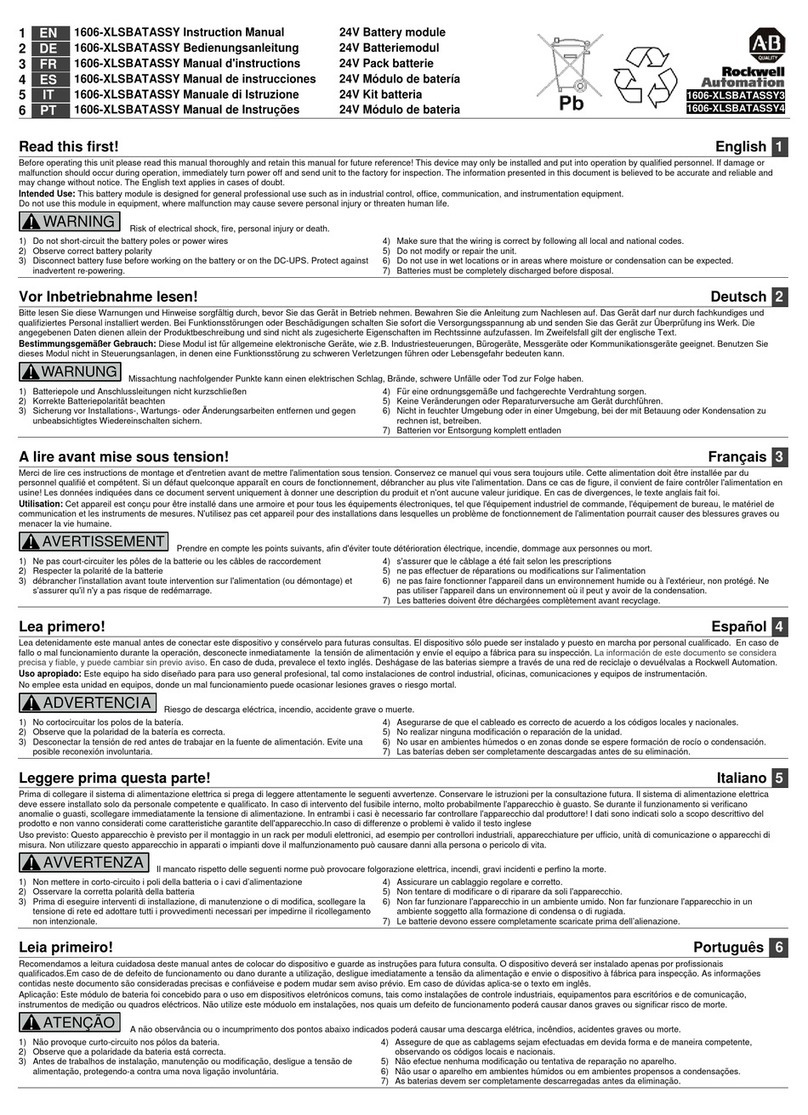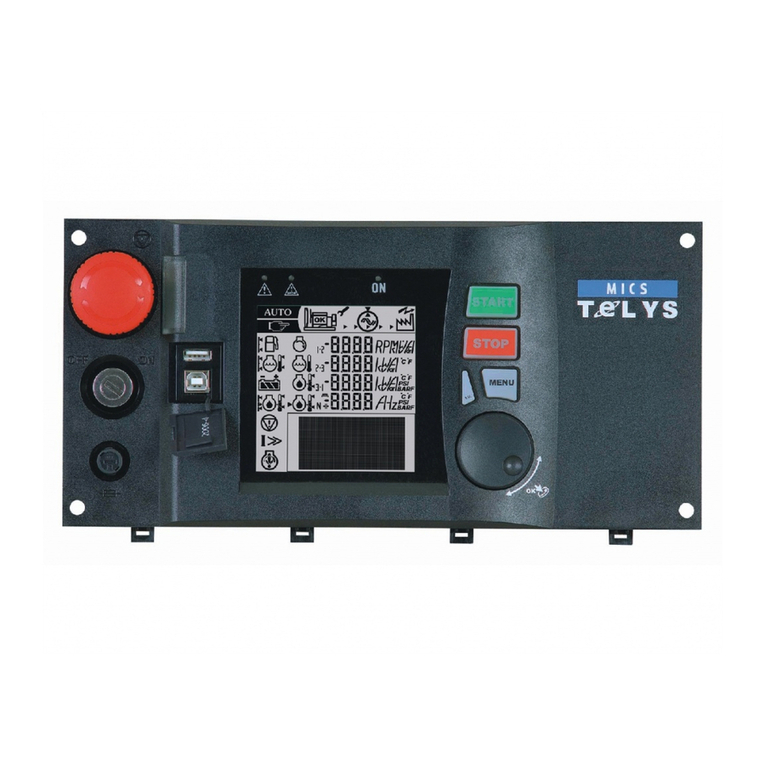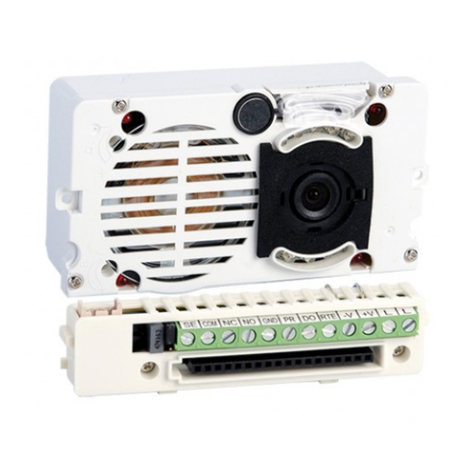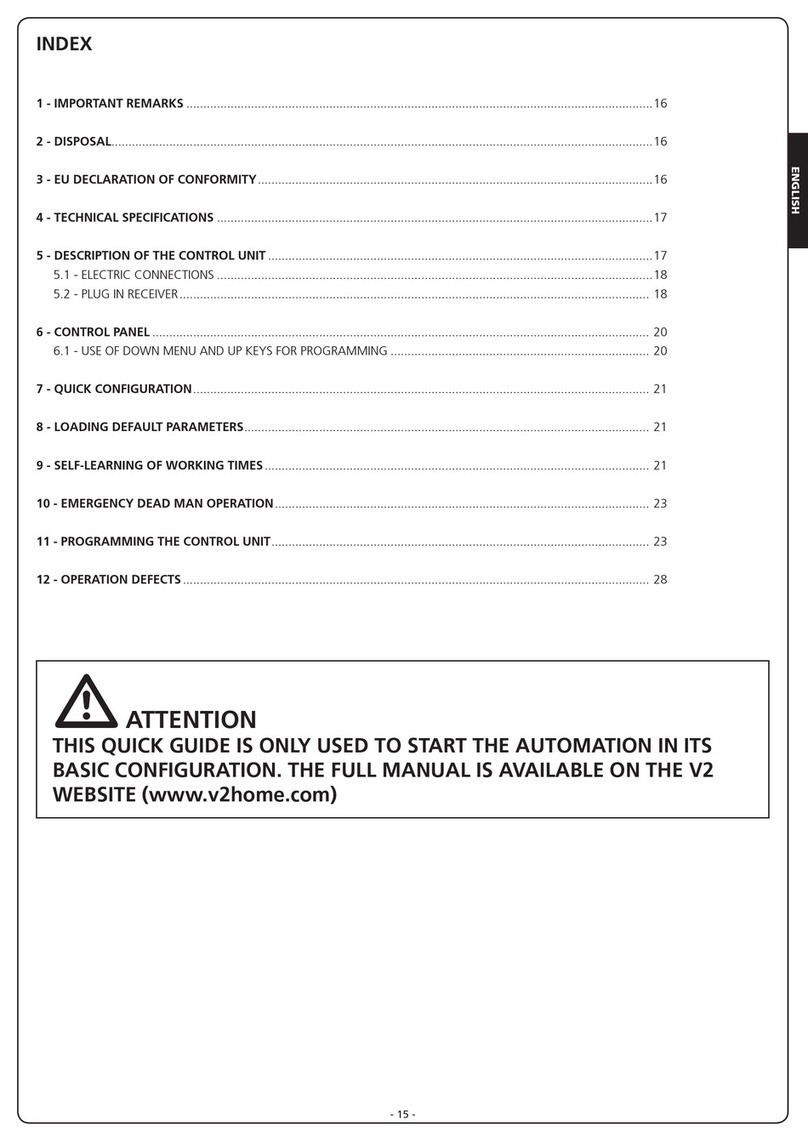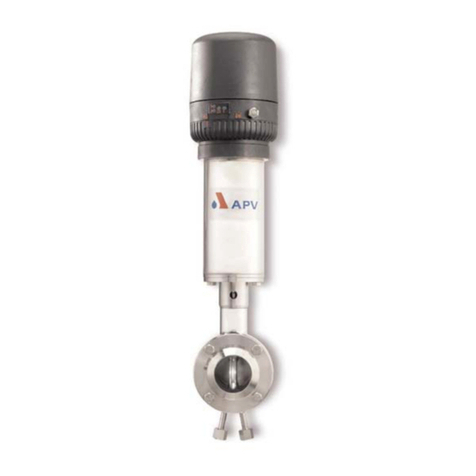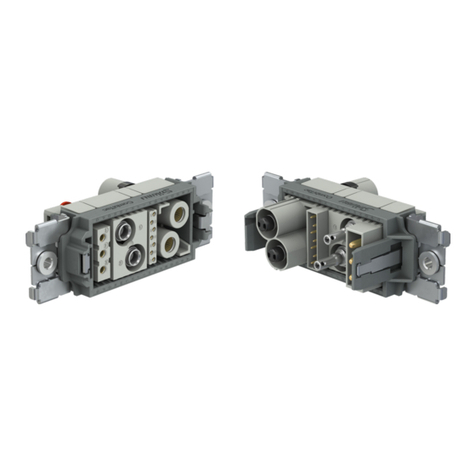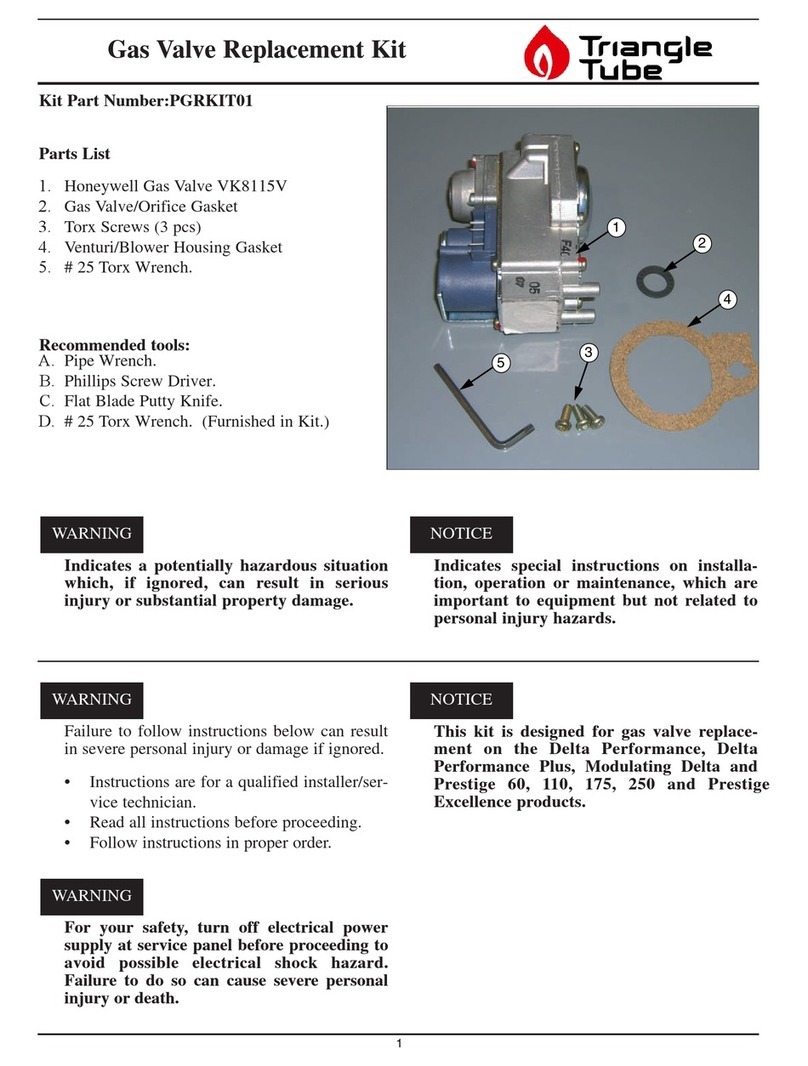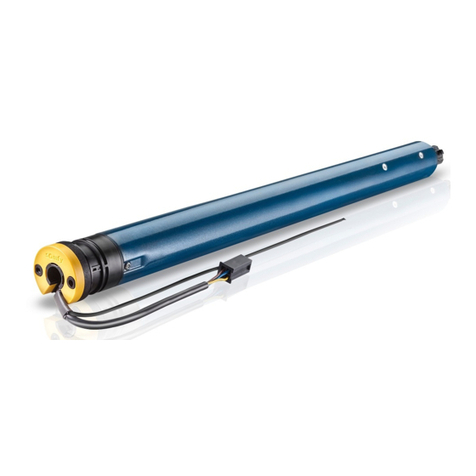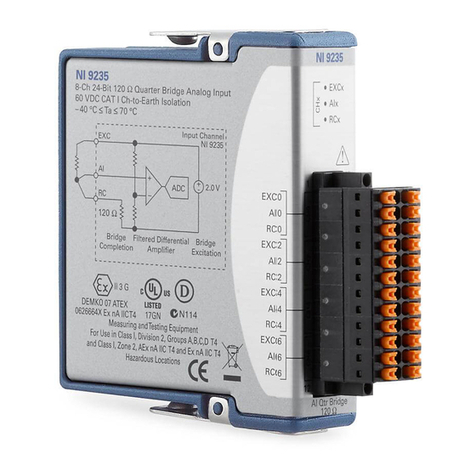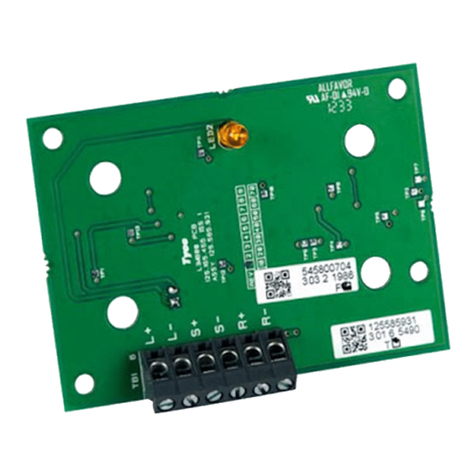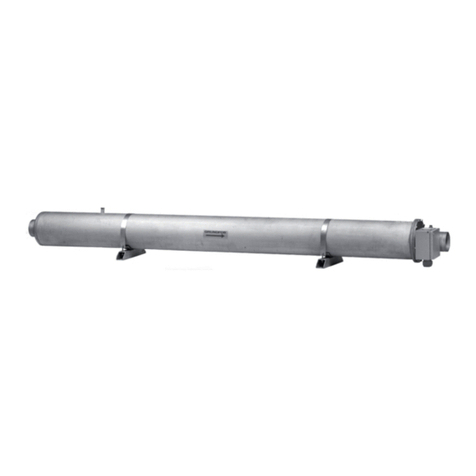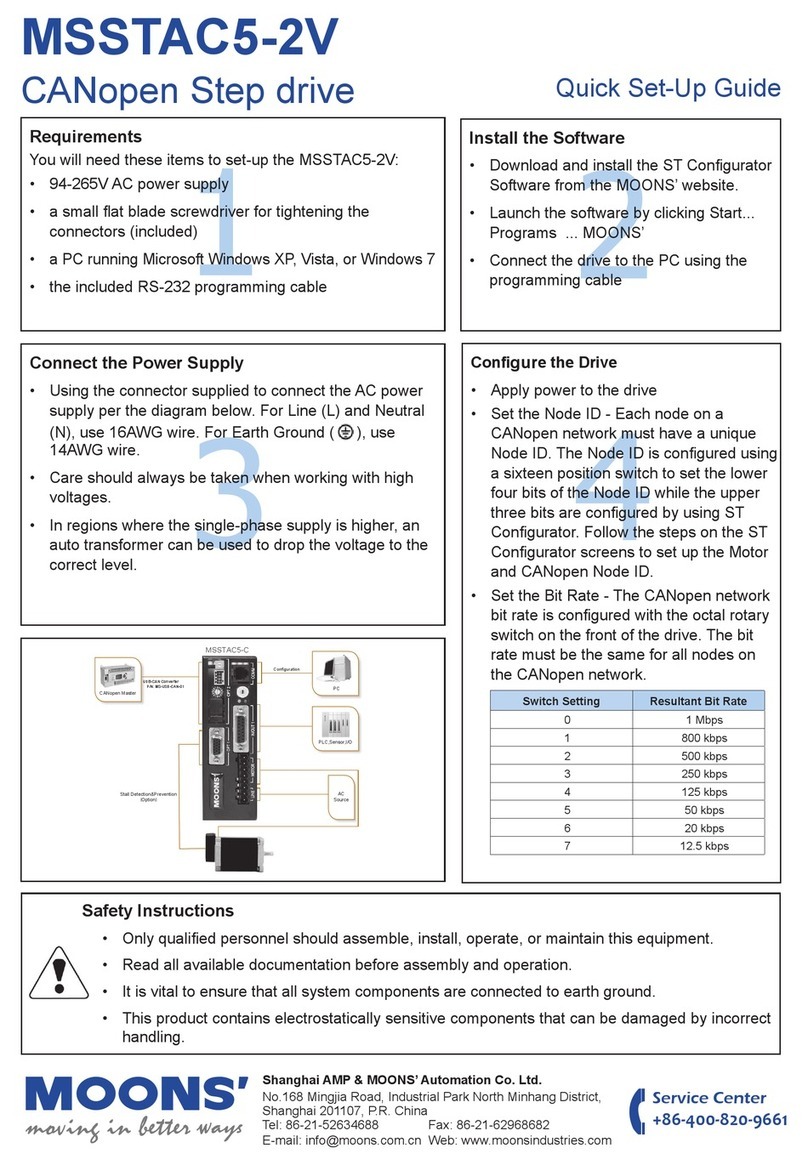GAS ESD5550 Series User manual

ENGINE
GOVERNING
ESD5550/5570 Series
SYSTEM
Speed Control Unit
Installation
Adjustments
The speed control unit is rugged enough to be placed in a
control cabinet or engine mounted enclosure with other
dedicated control equipment. If water, mist, or condensation
may come in contact with the controller, it should be mount-ed
vertically. This will allow the fluid to drain away from the speed
control unit. Extreme heat should be avoided.
An overspeed shutdown device, independent of the gover-
nor system, should be provided to prevent loss of engine
control, which may cause personal injury or equipment dam-
age. Do not rely exclusively on the governor system electric
actuator to prevent overspeed. A secondary shutoff device,
such as a fuel solenoid, must be used.
Wiring
Basic electrical connections are illustrated in Diagram 2 (for
the ESD5550, ESD5555 and the ESD5570) and Diagram 3
(for the ESD5556 only). Actuator and battery connections to
Terminals A, B, E, and F should be #16 AWG (1.3 mm2) or
larger. Long cables require an increased wire size to mini-
mize voltage drops. The battery positive (+) input, Terminal
F, should be fused for 15 amps as illustrated.
Magnetic speed sensor wires connected to Terminals C and D
MUST BE TWISTED AND/OR SHIELDED for their entire
length. The speed sensor cable shield should ideally be con-
nected as shown in Diagram 2 or 3. The shield should be
insulated to insure no other part of the shield comes in con-tact
with engine ground, otherwise stray speed signals may be
introduced into the speed control unit. With the engine stopped,
adjust the gap between the magnetic speed sensor and the ring
gear teeth. The gap should not be any smaller than 0.020 in.
(0.45 mm). Usually, backing out the speed sensor 3/4 turn after
touching the ring gear teeth will achieve a satisfactory air gap.
The magnetic speed sensor voltage should be at least 1 VAC
RMS during cranking.
Before Starting Engine
Before starting the engine, check and/or adjust the POTs/
switches to the following settings. See Table 1 for the fac-
tory presets.
Start Engine
The speed control unit governed speed setting is factory set
at approximately engine idle speed. (1000 Hz., speed sen-
sor signal) Crank the engine with DC power applied to the
governor system. The governor system should control the
engine at a low idle speed. If the engine is unstable after
starting, turn the GAIN and STABILITY adjustments CCW
until the engine is stable.
Adjusting Crank Termination (ESD5556 only)
To protect the engine from harm the CRANK TERMINATION
adjustment is factory set at full CCW [Lowest Setting]. To adjust
CRANK TERMINATION speed setting, rotate the CRANK
adjustment to full CW. Crank the engine and simul-taneously
turn the CRANK adjustment slowly CCW until the proper crank
termination speed is reached. In operation, when the cranking
termination set point is reached, the green CRANK LED will
illuminate. (Cranking has terminated).
The ESD5556 is set for manual reset. To reinstate engine
cranking, battery power must be removed and then reap-
plied which will recycle the control.
Adjusting Overspeed
When the engine is running at the desired speed, push and
hold the TEST button. Rotate the OVERSPEED adjustment
CCW until the red OVERSPEED LED lights and the relay
energizes. Current to the actuator will be removed and the
Table 1 factory presets
Adjustment / Switch
Potentiometer/Switch
Setting
Applicable Units
SPEED
25 turn
1470 Hz ± 50 Hz w/ min. trim
all
GAIN
270° turn
50%
all
STABILITY
270° turn
50%
all
DROOP
270° turn
0% (CCW)
all
IDLE
270° turn
1075± 75 Hz
all
STARTING FUEL RAMP
270° turn
100% (CW) Maximum Fuel
all
SPEED RAMP
270° turn
0% (CCW) Fastest
all
OVERSPEED
25° turn
100% (CW) Highest
all
CRANK TERMINATION
25° turn
0% (CCW) Lowest
ESD5556 only
SWI Lead Circuit
switch
ON
all
SW2 Soft Coupling
switch
OFF
all

engine will shut off.
Release the TEST button. After the engine stops, press the
RESET button or remove battery power. Restart the engine
and it will return to the original speed setting. The overspeed
function is now set to approximately 10% above the request-
ed speed.
If a different value of overspeed setting is required, raise the
engine speed to the desired overspeed value, i.e. 115%. Ro-
tate the OVERSPEED adjustment CCW until the red OVER-
SPEED LED lights and the relay energizes.
⚠WARNING
Always use the relay contacts provided to shut down the
system by a means other than the governor or actuator. It
is recom-mended that an overspeed protection sys-tem be
routinely tested and verified during the scheduled service
of equipment.
Governor Speed Setting
The governed speed set point is increased by a CW rotation
of the SPEED adjustment control. Remote speed adjust-
ment can be obtained with an optional 5K Speed Trim Con-
trol. (See Diagram 1.)
Governor Performance
Once the engine is at operating speed and at no load, the
following governor performance adjustment can be made.
A. Rotate the GAIN adjustment CW until instability devel-
ops. Gradually move the adjustment CCW until stability
returns. Move the adjustment one division further CCW
to insure stable performance.
B. Rotate the STABILITY adjustment clockwise until insta-
bility develops. Gradually move the adjustment coun-
terclockwise until stability returns. Move the adjustment
one division further to insure stable performance (270°
pot).
C. GAIN and STABILITY adjustments may require minor
changes after engine load is applied. Normally, ad-
justments made at no load achieve satisfactory perfor-
mance. A strip chart recorder can be used to further
optimize the adjustments.
If instability cannot be corrected or further performance
improvements are required, refer below to the SYSTEM
TROUBLESHOOTING section.
Starting Fuel Adjustment
The engine’s exhaust smoke at start-up can be minimized
by completing the following adjustments:
A. Place the engine in idle by connecting Terminals M & G.
B. Adjust the IDLE speed for as low a speed setting as the
application allows.
C. Adjust the STARTING FUEL CCW until the engine speed
begins to fall. Increase the STARTING FUEL slightly so
that the idle speed is returned to the desired level.
D. Stop the engine.
One of two methods of operation for the ESD5550/5570
may now selected. (See Table 2.)
Table 2 Starting Method
Method 1
Method 2
Start the engine and accelerate
Start the engine and control
directly to the operating speed
at an idle speed for a period of
(Gen Sets, etc.).
time prior to accelerating to the
operating speed. This method
separates the starting process
so that each may be optimized
for the lowest smoke emissions.
Remove the connection between
Replace the connection be-
Terminals M & G. Start the en-
OR
tween Terminals M & G with a
gine and adjust the SPEED
switch, usually an oil pressure
RAMPING for the least smoke
switch. Start the engine. If the
on acceleration from idle to rated
starting smoke is excessive,
speed. If the starting smoke is
the STARTING FUEL may need
excessive, the STARTING FUEL
to be adjusted slightly CCW. If
may need to be adjusted slightly
the starting time is too long, the
CCW. If the starting time is too
STARTING FUEL may need to
long, the STARTING FUEL may
be adjusted slightly CW.
need to be adjusted slightly CW.
When the switch opens, adjust
the SPEED RAMPING for the
least amount of smoke when
accelerating from idle speed to
rated speed.
Idle Speed Setting
If the IDLE speed setting was not adjusted as detailed in
‘Starting Fuel Adjustment’ section, then place the optional
external selector switch in the IDLE position. A CW adjust-
ment to the IDLE adjustment control will increase the idle
speed set point. When the engine is at idle speed, the speed
control unit applies droop to the governor system to insure
stable operation.
Speed Droop Operation
Droop is typically used for the paralleling of engine driven
generators.
Place the optional external selector switch in the DROOP po-
sition. DROOP is increased by CW rotation of the DROOP
adjustment control. When in droop operation, the engine
speed will decrease as engine load increases. The percent-
age of droop is based on the actuator current change from
engine no load to full load. A wide range droop is available
with the internal control. Droop level requirements above
10% are unusual.
If droop levels experienced are higher or lower then these
required, contact GAC for assistance.
After the droop level has been adjusted, the rated engine
speed setting may need to be reset. Check the engines
speed and adjust that speed setting accordingly.
2

Accessory Input
The AUXiliary Terminal N accepts input signals from load
sharing units, auto synchronizers, and other governor sys-
tem accessories. It is recommended that this connection
from accessories be shielded as it is a sensitive input ter-
minal.
If the auto synchronizer is used alone, not in conjunction with
a load sharing module, a 3Ωresister should be connected
between Terminals N and P. This is required to match the
voltage levels between the speed control unit and the syn-
chronizer.
When an accessory is connected to Terminal N, the speed
will decrease and the speed adjustment must be reset.
When operating in the upper end of the control unit frequen-
cy range, a jumper wire or frequency trim control may be
required between Terminals G & J. This increases the fre-
quency range of the speed control to over 7000 Hz.
Accessory Supply
The +10 VDC regulated supply, Terminal P, can be utilized
to provide power to GAC governor system accessories. Up
to 20 mA of current can be drawn from this supply. Ground
reference is Terminal G. Caution: a short circuit on Terminal
P could damage the speed control unit.
Table 3 Variable speed range Potentiometer
Speed Range
Potentiometer
900 Hz
1K
2,400 Hz
5K
3,000 Hz
10K
3,500 Hz
25K
3,700 Hz
50K
Wide Range Remote Variable Speed Operation
Simple and effective remote variable speed can be obtained
with the ESD5550/5570 Series control unit using an external
potentiometer.
A single remote speed adjustment potentiometer can be used
to adjust the engine speed continuously over a specific speed
range. Select the desired speed range and corre-sponding
potentiometer value. (Refer to Table 3.) If the exact range
cannot be found, select the next higher range poten-tiometer.
An additional fixed resistor may be placed across the
potentiometer to obtain the exact desired range. Con-nect the
speed range potentiometer as shown in Diagram 1.
To maintain engine stability at the minimum speed setting, a
small amount of droop can be added turn the DROOP
adjustment CW. At the maximum speed setting the gover-
nor performance will be near isochronous, regardless of the
droop adjustment setting.
Contact GAC for assistance if difficulty is experienced in ob-
taining the desired variable speed governing performance.
Diagram 1 Variable Speed Pot
*
cw
*Select Proper Potentiometer Value from Table 3.
SYSTEM TROUBLESHOOTING
SYSTEM INOPERATIVE
If the engine governing system does not function, the fault may be determined by performing the voltage tests described in Steps 1, 2, 3 and 4. [+] and [-] refer to
meter polarity. Should normal values be indicated as a result of following the troubleshooting steps, the fault may be with actuator or the wiring to
the actuator. See the actual publication for testing details.
Steps
Terminals
Normal Reading
Probable Cause of Abnormal Reading
1
F(+) & E(-)
Battery Supply Voltage 12 or
1.
DC battery power not connected. Check for blown fuse.
24 VDC
2.
Low battery voltage.
3.
Wiring error.
2
C & D
1.0 VAC RMS min., while
1.
Gap between speed sensor and gear teeth too great. Check gap.
cranking.
2.
Improper or defective wiring to the speed sensor. Resitance between Terminals C & D
should be should be 30 to 1200 Ω.
3
P(+) & G(-)
10 VDC, Internal Supply.
1.
Short on Terminal P. (This will cause a defective unit.)
2.
Defective Speed Control.
4
F(+) & A(-)
1.0 - 2.0 VDC while cranking.
1. Speed Adjustment set too low.
2. Short/open in actuator wiring.
3. Defective speed control.
4. Defective actuator. See Actuator Troubleshooting.
3

UNSATISFACTORY PERFORMANCE
If the engine governing system functions poorly, preform the following test.
Symptom
Test
Probable Fault
Engine overspeeds.
1. Do not crank. Apply DC power to
1. Actuator goes to full fuel. Then, disconnect speed sensor at Terminals C & D. If the actuator is still at full fuel - the
the governor system.
speed control is defective. If the actuator is still at minimum fuel fuel position - erroneous spped signal. Check speed
sensor data.
2. Manually hold the engine at the
1. If the voltage speed reading is 1.0 to 2.0 VDC; a.) SPEED adjustment is set above desired speed. b.) Defective
desired running speed. Measure the
speed control unit.
DC voltage between Terminals A (-) &
2. If the voltage reading is above 2.0 VDC; a.) Actuator or linkage binding.
F(+) on the speed control unit.
3. If the voltage reading is below 1.0 VDC; a.) Defective speed control unit.
4. Gain set too low.
Actuator does not energize fully.
1. Measure the voltage at battery while
1. If the voltage is less than 7VDC for a 12VDC system or less than 14VDC for a 24VDC system, replace the battery if
cranking.
it is weak or undersized.
2. Momentarily connect Terminal A &
1. Actuator or battery wiring in error.
F. The actuator should move to full
2. Actuator or linkage bringing.
throttle position.
3. Defective actuator. See actuator troubleshooting.
4. Fuse opens. Check for short in actuator or actuator wiring harness.
Engine remains below desired
1. Measure the actuator output.
1. If voltage measurement is within approx. 2 volts of the battery supply voltage, then fuel control restricted from reach-
governed speed.
Terminal a & B, while running under
ing full fuel position. Possible due to interference from the mechnical governor, carburetor spring or linkage alignment.
governor control.
2. Speed setting too low.
Insufficient Magnetic Speed Signal
A strong magnetic speed sensor signal will eliminate the
possibility of missed or extra pulses. The speed control unit
will govern well with 0.5 volts RMS speed sensor signal. A
speed sensor signal of 3 volts RMS or greater at governed
speed is recommended. Measurement of the signal is made
at Terminals C and D.
The amplitude of the speed sensor signal can be raised by
reducing the gap between the speed sensor tip and the
engine ring gear. The gap should not be any smaller than
0.020 in (0.45 mm). When the engine is stopped, back the
speed sensor out by 3/4 turn after touching the ring gear
tooth to achieve a satisfactory air gap.
Electromagnetic Compatibility (EMC)
EMI SUSCEPTIBILITY - The governor system can be ad-
versely affected by large interfering signals that are conduct-
ed through the cabling or through direct radiation into the
control circuits.
All GAC speed control sensors contain filters and shielding
designed to protect the unit’s sensitive circuits from mod-
erate external interfering sources. Although it is difficult to
predict levels of interference, applications that include mag-
netos, solid sate ignition systems, radio transmitters, voltage
regulators or battery chargers should be considered suspect
as possible interfering sources.
If it is suspected that external fields, either those that are
radiated or conducted, are or will affect the governor sys-
tems operation, it is recommended to use shielded cable for
all external connections. Be sure that only one end of the
shields, including the speed sensor shield, is connected to a
single point on the case of the speed control unit. Mount the
speed control to a grounded metal back plate or place it in a
sealed metal box.
Radiation is when the interfering signal is radiated directly
through space to the governing system. To isolate the gover-
nor system electronics from this type of interference source, a
metal shield or a solid metal container is usually effective.
Conduction is when the interfering signal is conducted
through the interconnecting wiring to the governor system
electronics. Shielded cables and installing filters are com-
mon remedies.
In severe high-energy interference locations such as when
the governor system is directly in the field of a powerful
transmitting source, the shielding may require to be a spe-
cial EMI class shielding. For these conditions, contact GAC
application engineering for specific recommendations.
Instability
Instability in a closed loop speed control system can be
categorized into two general types. PERIODIC appears to
be sinusoidal and at a regular rate. NON-PERIODIC is a
random wandering or an occasional deviation from a steady
state band for no apparent reason.
Switch C1 controls the “Lead Circuit” found in the
ESD5550/5556/5570. The normal position is “ON.” Move the
switch to the “OFF” position if there is fast instability in the
system.
Switch C2 controls an additional circuit added in the
ESD5550/5570 that is designed to eliminate fast erratic gov-
ernor behavior, caused by very soft or worn couplings in the
drive train between the engine and generator. The normal
position is “OFF.” Move to the “ON” position if fast erratic en-
gine behavior due to a soft coupling is experienced.
The PERIODIC type can be further classified as fast or slow
instability. Fast instability is a 3 Hz. or faster irregularity of the
speed and is usually a jitter. Slow periodic instability is below 3
Hz., can be very slow, and is sometimes violent.
If fast instability occurs, this is typically the governor respond-
ing to engine firings. Raising the engine speed increases the
frequency of instability and vice versa. In this case, plac-ing
switch C1 in the “OFF” position will reduce the speed control
unit’s sensitivity to high frequency signals. Readjust the GAIN
and STABILITY 1or optimum control. Should in-stability still be
present, the removal of E1 to E2 jumper may help stabilize the
engine. Post locations are illustrated in
4

Diagram 1. Again, readjust the GAIN and STABILITY for
optimum control. Interference from powerful electrical sig-
nals can also be the cause. Turn off the battery chargers or
other electrical equipment to see if the system instability
disappears.
Slow instability can have many causes. Adjustment of the
GAIN and STABILITY usually cures most situations by
matching the speed control unit dynamics. If this is unsuc-
cessful, the dead time compensation can be modified. Add
a capacitor from posts E2 to E3 (negative on E2). Post loca-
tions are illustrated in Diagram 1. Start with 10 mfds, and
increase until instability is eliminated. The control system
can also be optimized for best performance by following this
procedure.
If slow instability is unaffected by this procedure, evaluate
the fuel system and engine performance. Check the fuel
system linkage for binding, high friction, or poor linkage. Be
sure to check linkage during engine operation. Also look at
the engine fuel system. Irregularities with carburetion or fuel
injection systems can change engine power with a constant
throttle setting. This can result in speed deviations beyond
the control of the governor system. Adding a small amount
of droop (Jumper K-L) can help stabilize the system for trou-
bleshooting.
NON-PERIODIC instability should respond to the GAIN con-
trol. If increasing the gain reduces the instability, then the
problem is probably with the engine. Higher gain allows the
governor to respond faster and correct for disturbance. Look for
engine misfirings, an erratic fuel system, or load changes on the
engine generator set voltage regulator. If the throttle is slightly
erratic, but performance is fast, move switch C1 to the “OFF”
position. This will tend to steady the system.
If unsuccessful in solving instability, contact GAC for assis-
tance.
Specifications
PERFORMANCE
Isochronous Operation/Steady State Stability ...................±0.25% or better
Speed Range/Governor……………………………....1K-7.5K Hz continuous
Speed Drift with Temperature................................................
±1% Maximum
Idle Adjust CW...................................................................
60% of set speed
Idle Adjust CCW.............................................................
Less than 1200 Hz.
Crank Termination Adjustment Range.....................................
300-2200 Hz.
Droop Range....................................................................
1 - 5% regulation*
Droop Adj. Max. (K-L Jumpered) ..........
400 Hz., ± 75 Hz. per 1.0 A change
Droop Adj. Min. (K-L Jumpered)................
15 Hz., ± 6 Hz. per 1.0 A change
Speed Trim Range ........................................................................
± 200 Hz.
Remote Variable Speed Range .................
500 - 7.5 Hz. or any part thereof
Speed Switch Adjustment Range........................................
1000-10000 Hz.
Terminal Sensitivity
J ...............................
100 Hz., ± 15 Hz / Volt @ 5.0 K Impedance
L ................................
735 Hz., ± 60 Hz / Volt @ 65 K Impedance
N.............................
148 Hz., ± 10 Hz / Volt @ 1 Meg Impedance
P.....................................................
10 VDC Supply @ 20 ma Max
Speed Switch Adjustment Range........................................
1000-10000 Hz.
INPUT POWER
Supply...........................................................
12 or 24 VDC Battery Systems
(Transient and Reverse Voltage Protected)**
Polarity......................................................
Negative Ground (Case Isolated)
Power Consumption........................
50 mA continuous plus actuator current
Actuator Current Range @ 77°F (25°C) - (Inductive Load)............................
..................................................
Min. 2.5Amps.. Max. 10Amps continuous***
Speed Sensor Signal.......................................................
0.5-120 Volts RMS
Speed Switch Relay Contacts (N.O. and N.C.)
...............................10 Amps
ENVIRONMENTAL
Ambient Operating Temperature Range.......-40° to +180°F (-40° to +85°C)
Relative Humidity .........................................................................
up to 95%
All Surface Finishes.........................
Fungus Proof and Corrosion Resistant
RoHS Regulation...........................................................................
Compliant
RELIABILITY
Vibration...........................................................................
1G @ 20 -100 Hz.
Testing .................................................................
100% Functionally Tested
PHYSICAL
Dimensions .........................................................
See Outline (DIAGRAM 1)
Weight ...........................................................................
1.8 lbs. (820 grams)
Mounting---------------------------------------------
Any Position, Vertical Preferred
COMPLIANCE / STANDARDS
Agency…...........................................................................CE Requirements
*Droop is based on a speed sensor frequency of 4000 Hz. and an actuator current change of 1 amp from no
load to full load. Applications with higher speed sensor signals will experience less percent-age of droop.
Applications with more actuator currant change will experience higher percentages of droop. See droop
description for specific details on operation of droop ranges.When used with the ADC100 actuator the droop
percentage will he less due to the actuators low current consumption.
**Protected against reverse voltage by a series diode. A I5 amp fuse must be installed in the posi-
tive battery lead.
***Protected against short circuit to actuator (shuts off current to actuator), unit automatically turns
back on when short is removed.
5

Diagram 2 System Wiring and Outline (for ESD5550, Esd5555 and Esd5570 only)
6.00
(152)
Ø0.27(7)
5.25
(133)
O.S.
TEST
1 OFF
ON 2
LEAD
SOFT
OVERSPEED
CIRCUIT
COUPLING
ON
OFF
MERICA
1 2 3
RESET TEST
OVERSPEED
SPEED CONTROL UNIT
MODEL: ESD55xx
SPEED
S/N :
GAIN
MADE IN AGAWAM, MA U.S.A.
6.50 6.00
STABILITY
OVER
(165) (152)
STARTING
SPEED
SPEED
FUEL
RAMPING
DEAD TIME
DROOP
COMPENSATION
ENGINE SPEED CONTROL
JUMPER
COMPONENT. WHEN INSTALLING
OR SERVICING, REFER TO
PRODUCT PUBLICATION
PICK-UP
-
+
IDLE
10V
ACTUATOR
BATTERY
AUX OUTPUT
A B C D E F G H J K L M N P
OPTIONAL ACTUATOR
CABLE SHIELDING TO
MEET CE DIRECTIVE
*
ACTUATOR
MAGNETIC
CW
PICK-UP
_
SPEED TRIM
+
CONTROL - 5K
S1
BATTERY
FUSE
15A MAX
ACCESSORY POWER
SUPPLY
ACCESSORY INPUT
ADD JUMPER FOR 12V
BATTERY OR ACTUATOR
CURRENTS ABOVE 5A
GROUND REFERENCE
CLOSE FOR DROOP
CLOSE FOR IDLE
*SEE SPECIFIC ACTUATOR PUBLICATION FOR PROPER WIRING OF
ACTUATOR BASED ON BATTERY VOLTAGE
6

Diagram 3 System Wiring and Outline (for Esd5556 only)
6.00
(152)
Ø0.27(7)
5.25
(133)
CRANK
O.S.
OVERSPEED
TEST
O.S.
1
2 3 4 5 6
RESET
1
LEAD
SOFT
OFF
ON 2
CIRCUIT
COUPLING
ON
OFF
SPEED CONTROL UNIT
CRANK
MODEL:
ESD5556
SPEED
S/N :
GAIN
MADE IN AGAWAM, MA U.S.A.
6.50
6.00
STABILITY
OVER
SPEED
(165) (152)
STARTING
SPEED
FUEL
RAMPING
ENGINE SPEED CONTROL
DROOP
COMPONENT. WHEN INSTALLING
OR SERVICING, REFER TO
PRODUCT PUBLICATION
PICK-UP
-
+
IDLE
10V
ACTUATOR
BATTERY
AUX OUTPUT
A B C D E F G H J K L M N P
DEAD TIME
COMPENSATION
JUMPER
OPTIONAL ACTUATOR
CABLE SHIELDING TO
MEET CE DIRECTIVE
*
ACTUATOR
MAGNETIC
CW
PICK-UP
_
SPEED TRIM
+
CONTROL - 5K
BATTERY
FUSE
15A MAX
ACCESSORY POWER
SUPPLY
ACCESSORY INPUT
ADD JUMPER FOR 12V
BATTERY OR ACTUATOR
CURRENTS ABOVE 5A
GROUND REFERENCE
CLOSE FOR DROOP
CLOSE FOR IDLE
*SEE SPECIFIC ACTUATOR PUBLICATION FOR PROPER WIRING
OF ACTUATOR BASED ON BATTERY VOLTAGE
7
This manual suits for next models
1
Table of contents
Popular Control Unit manuals by other brands
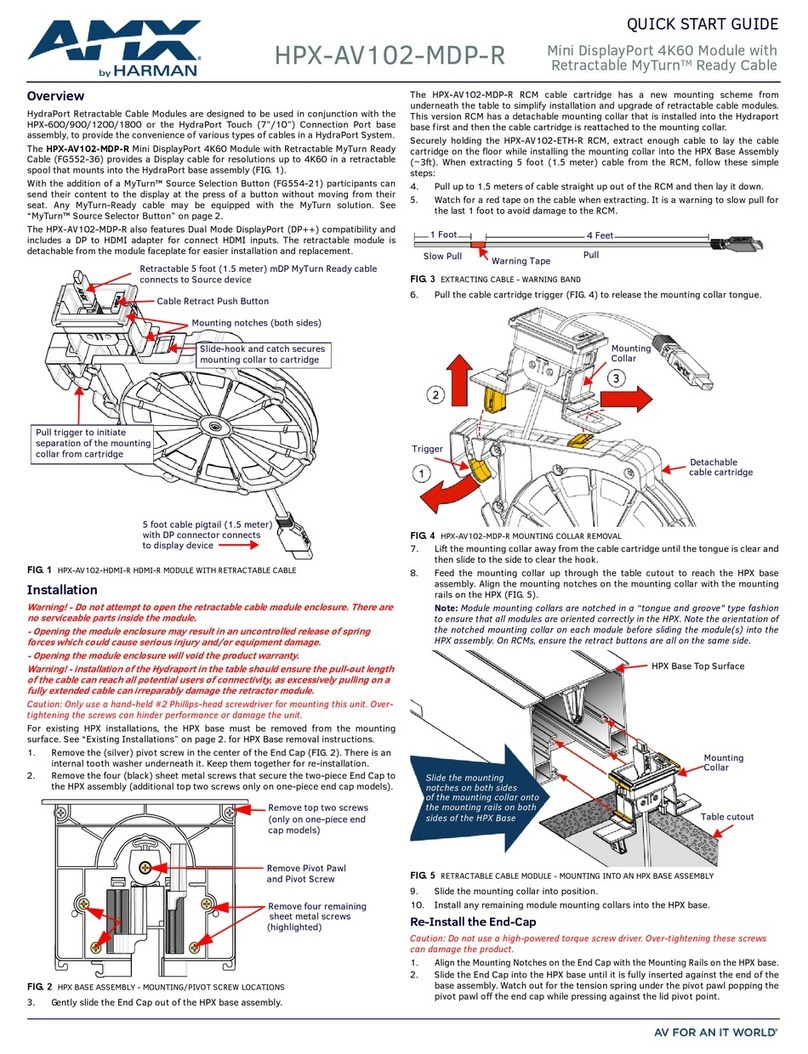
Harman
Harman AMX HPX-AV102-MDP-R quick start guide
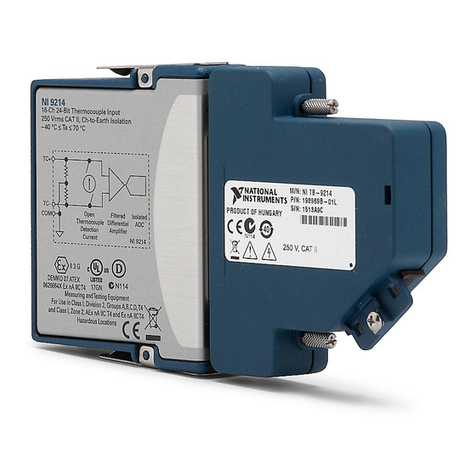
National Instruments
National Instruments NI 9214 Operating instructions and specifications
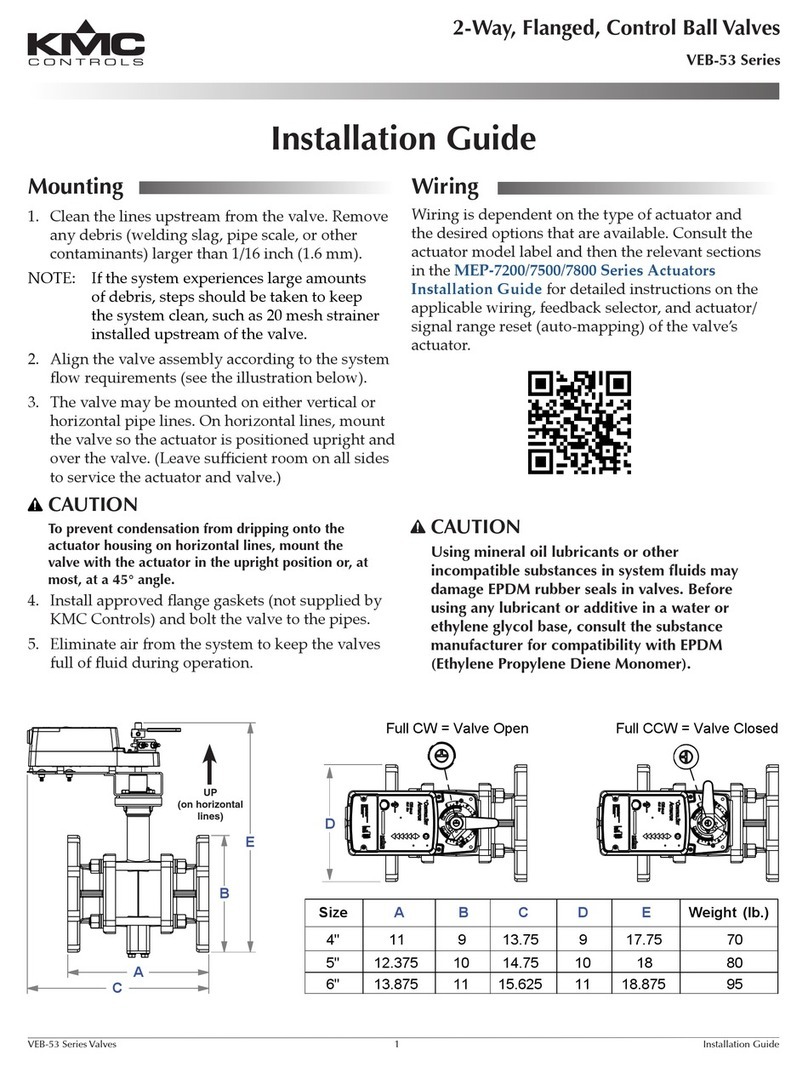
KMC Controls
KMC Controls VEB-53 Series installation guide

artisan
artisan ITC8 Series Operation manual

Epson
Epson RX8804CE Applications manual

Dover
Dover PSG BLACKMER AIR VALVE Installation, operation and maintenance instructions
